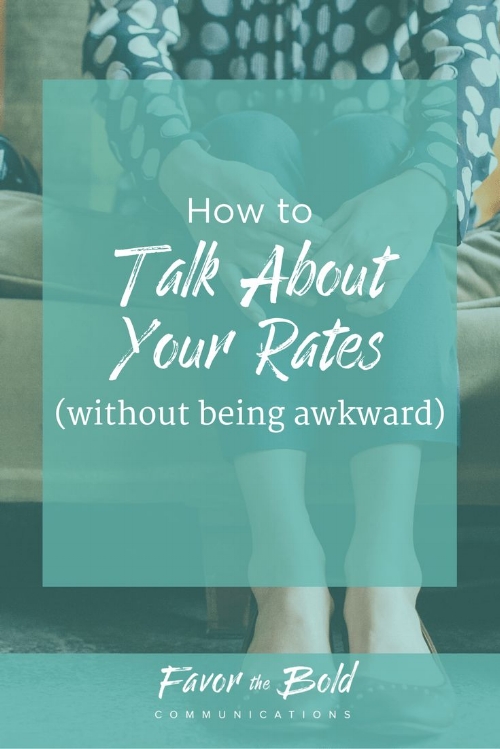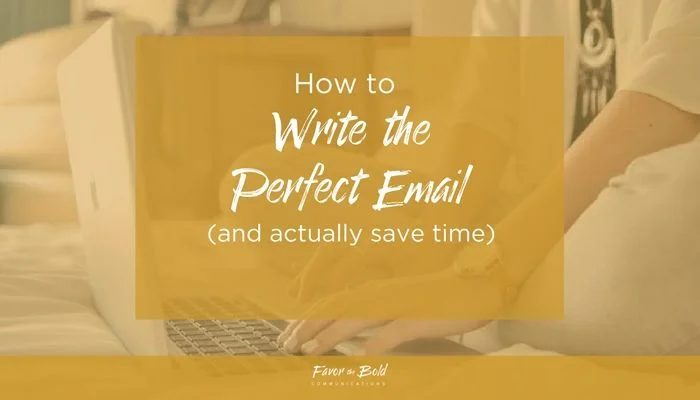Have you ever been in one of those situations where the person you’re talking to seems so uncomfortable that it makes you uncomfortable?
Then, they sense your discomfort, which makes them even more uncomfortable, which makes you even more uncomfortable, and then what started out as a normal conversation devolves into a horrendous cycle of increasing discomfort until one of you finally finds an excuse to end the conversation and put you both out of your misery.
Or am I alone on this one?
I’m thinking about awkward conversations because I was recently talking to another service provider that I wanted to hire. Everything was going well until I asked her about her rates.
That’s when things got real uncomfortable, real quick.
I wish I could’ve recorded what came next, but that’s super mean, not to mention probably illegal, so I’ll just describe it.
First, she got visibly uncomfortable and mumbled her hourly rate so quickly I hardly heard it. Then, she launched into a 3-minute monologue about how her rate was comparable to the market and was actually much cheaper than most agencies and now that she thinks about it, is even less than what she pays her kid’s tennis coach. She took half a breath and then specified that the rate was negotiable and she’s sure we can work something out and if it’s too much, she totally understands. She finally ended her speech, miserable and out of breath, and stared at me mournfully, awaiting my verdict.
It was crazy.
And even crazier? Her rate was totally reasonable. Like, way under what I thought it’d be. The rate didn’t freak me out at all-- but she kinda did!
That super awkward exchange got me thinking about how we talk about our rates. I hear all the time from service-based solopreneurs that they hate telling potential clients how much their work will cost. How they’re afraid people will balk at the number and find someone cheaper.
Listen, I’m not immune to it either. I’m confident I can back up my prices with the value I bring to my clients’ businesses, but I still can’t send a proposal without hyperventilating a little bit.
That said, I’ve learned how to talk about my rates without freaking out and being super awkward, and I want to share what I’ve learned with you
1. Pick a number you’re comfortable with and stick with it.
The first step to not being awkward when talking about your prices is to set prices you’re comfortable with. Personally, I’m not an intuitive pricing kinda gal-- I’ve chosen my rates based on the hourly wage I need to have the quality of life I want.
And I recommend you do the same.
Sit down and do the math: how much do you need to make per hour to pay your bills? I’m not going to get into whether you should price by the hour or by project here, but either way, you need to be sure your prices reflect the value you bring to clients, while also ensuring you don’t have to eat ramen noodles every meal to survive.
One clarification on the “stick with it” part: I mean stick with it when telling potential clients your rates. I definitely don’t mean stick with the number forever and ever. As your experience grows, so does the value you bring to clients-- and you’ll most likely need to raise your rates.
2. Practice saying your rates.
Once you have your number, practice saying it out loud. I’m serious here: stand in front of a mirror and say, out loud, “My hourly (or project) rate is X.”
Notice there’s a period on the end of that sentence. When we’re uncomfortable with a statement, many of us-- women especially-- can add an inflection at the end of our sentences, making them sound like a question.
Your rates are not questionable, they’re fact. So make sure you’re stating them as a fact.
3. Don't just say your number, frame your number.
While you’re standing in front of the mirror, I’d like you to practice something else as well.
Let’s say a potential coaching client asks how much your coaching package is. Instead of just responding with, “My coaching package is $699,” frame the number first by telling them what they’ll get for that amount. The goal here is to make them want what you’re offering so much that by the time you tell them the rate, price isn’t even an issue-- they’ve already said yes in their minds.
Now, here you might be tempted to say, “My coaching package includes three one-hour sessions and a final recap email for $699.”
Don’t do that.
When I say, “Tell them what they’ll get,” I mean, “help them understand the value you’ll bring them.” Think benefits, not features. A feature is an hour-long Skype session. A benefit is what that hour-long skype session will do for the client.
So if you’re focusing on benefits more than features, you might say:
“That package includes three 60-minute sessions where we’ll explore why you feel so overwhelmed, and create strategies to help you figure out your next step. At the end of each session, you’ll have a list of priorities for the week so you’ll be able to tackle your to-do list without feeling so stressed out. When we've finished our sessions together, I’ll send you an action plan that outlines the next steps you need to stay organized and keep making progress towards your business goals, even after we stop working together. The rate for that package is $699.”
See the difference? A potential client doesn’t really care about what your coaching package includes, they care about what they’ll get from it.
4. Don’t explain or apologize for your rate.
Remember my story about the lady who freaked out when telling me her (super reasonable) rate? Don’t do what she did.
The more confident you are when telling someone your rate, the more confident they’ll be in accepting it. If you make it sound like you think the number is too high, they’ll most likely think it’s too high as well.
But let’s be honest here: sometimes, no matter how confident you are, someone might question your rates. That’s normal, so you should be prepared for it.
Have a quick pitch in your back pocket that could help someone better understand the value you would bring them that justifies your price. You don’t need a long-winded explanation (please, don’t give a long-winded explanation) and you definitely shouldn’t get defensive, but having a couple sentences prepared to help educate your prospect can be the difference between a sale and a lost lead.
5. Don’t give discounts.
As a service-based entrepreneur, there will likely be times when a potential client responds to your rates with, “That’s too much-- it’s out of my budget.” You want the contract (or if you’re just starting out, probably need the contract), so you might be tempted to offer them a discount.
Don’t.
Please, please, please: do not devalue your work. If you’ve run the numbers and you know the rate you need to stay in business, do not let someone convince you it’s too much.
“I know, Elissa,” you say. “But I really need this contract.”
Dude, I get it. I really do. Which is why I’d like to offer a third option:
Offer a bonus instead.
If a potential client thinks your prices are too high for what they get (and you still want to work with them), offer slightly more work for the same price. Make them think they’re getting a deal, while also making sure you can still pay your bills.
So if you’re a graphic designer doing a brand board, could you add an extra logo variation or pattern to the board for free? If you’re a coach, could you add a 30-minute follow-up call after the package ends? You’d be surprised how a little gesture like that can make someone much more comfortable with the price.
Now, if your prices really are out of a potential client’s budget and a bonus won’t work, I have one last option:
Offer a smaller package.
But before you do, there are two points to keep in mind:
Make sure they understand what they’re not getting.
Be 100% clear that this is a smaller, cheaper package that might better fit their budget. What you want to avoid is them thinking that they’re getting the bigger package at a discount, and then being disappointed when they don’t get everything they wanted. Another benefit of this approach is that when you outline what they won’t be getting (and make sure to describe allll the benefits that they’re missing), they might magically find some room in their budget for the bigger package. Funny how that works, huh?
Make sure it’s still worth your time.
Sometimes there is no smaller package for a very good reason: it just isn’t worth it. Client management takes time. A smaller package might not be worth the time and effort you spend on the contract, onboarding, intake, review, revision, invoicing and payment. And that’s ok. If you don’t have a “smaller package” for a reason, stick to your guns and let the potential client know that you can’t help them.
6. Ok, ok, you can give discounts (but only for a really good reason.)
Full disclosure: I talk a big game about not giving discounts, but just last week I gave a discount. Before you call me a hypocrite and close out of this window, let me explain why I did it-- and why the “No Discount” rule is flexible.
I decided to give a discount to an old friend from my hometown for a type of work I haven’t yet done for clients, but really want to start doing. He has a successful business and incredible contacts in an industry where I see a huge market for my copywriting services. Working with him is a great opportunity to build my portfolio, get a kickass testimonial, get my foot in the door in a lucrative market and do something nice for an old buddy.
Plus, he didn’t even ask for the discount.
If you decide to offer a discount, do it because there’s something in it for you in the long run, not because someone asks for it. Do it because you need the experience, or the testimonial, or the word-of-mouth in a new market, or because it’s an old buddy and you used to shoot pumpkins together with his dad's hunting rifle. (Stop judging me, I’m from Missouri and I was 16-- that’s what you do.)
But if you do offer a discount, promise me you’ll do one thing. Seriously, I’m not going to tell you what it is until you say to yourself, “I promise to do this every single time I offer a discount.”
Did you say it?
If you offer a discount, you must tell them it’s a discounted introductory rate and that any additional work will be full price. You do not want to get yourself in a situation where you’re accepting project after project at a rate you can’t live off of.
If it really is a dream client and you did good work the first time around, they’ll be happy to pay your full rate on subsequent projects-- but only if they know that ahead of time.
7. Don’t try to be the cheapest.
I saved this one for last because it’s so, so important: don’t try to win contracts by competing on price.
Unless you’re Walmart or McDonalds (in which case, thanks for reading my blog, I guess?) you’ll never win the price game-- so don’t even play. There will always be someone cheaper and you’ll be there working for peanuts and still not getting clients.
Plus-- and I cannot say this enough-- you do not want to work with the kinds of clients who make their decision based on price. Those are nightmare clients. They’re cheap. They’re demanding. They don’t understand the work you do and therefore don’t value it. They will suck out your soul, chew it up, spit it out, kick some dirt on it and still ask for a discount.
Remember when I said that your price should represent the value you bring? Any time you’re tempted to lower your rates, repeat after me: “I bring value to my clients.”
What you do has value. You have value.
And you shouldn’t work with anyone who doesn't see it.











![How to boost your brand offline-- and get more business [Part 3]](https://images.squarespace-cdn.com/content/v1/5671d7a82399a31f114f4c55/1477565172008-2K7456WNHWYM99T12HTV/How+to+boost+your+brand+offline--+and+get+more+business.jpg)